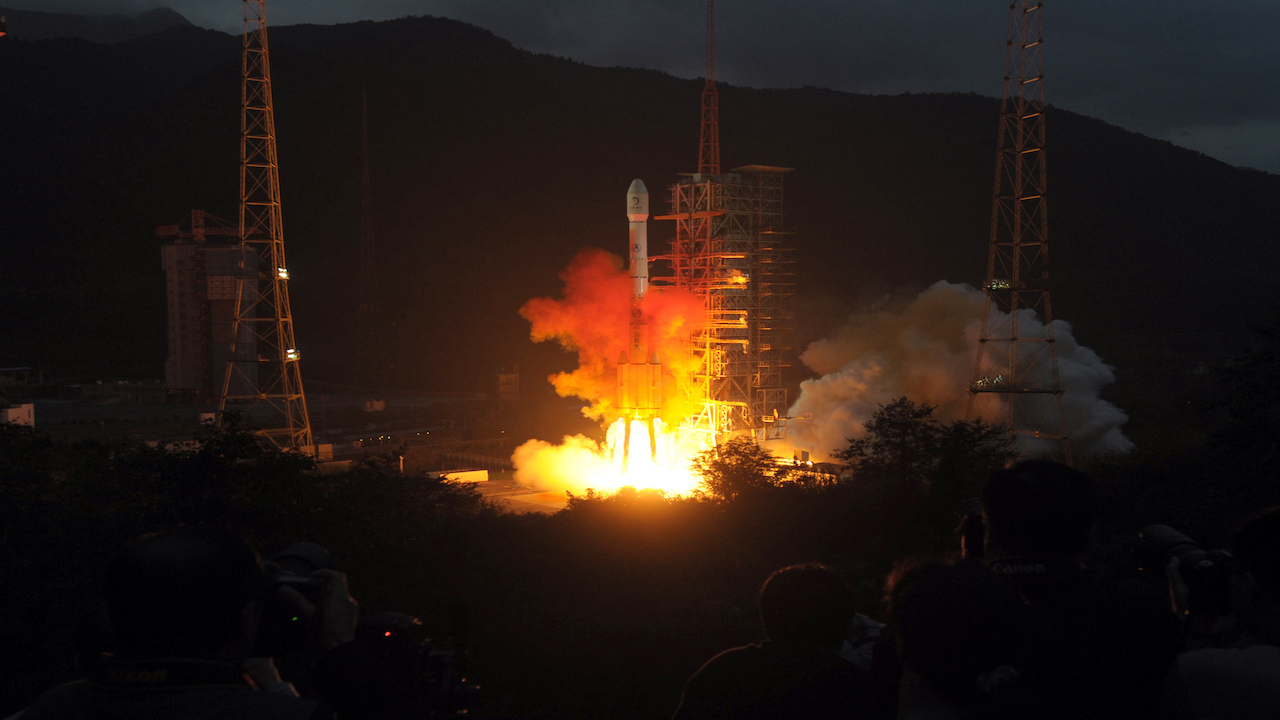Rogue rocket about to smash into the moon is from China, not SpaceX, experts say
The object likely came from a Chinese rocket launched in 2014

A rocket stage set to smash into the moon on March 4 is no longer believed to be a piece of a SpaceX Falcon 9 rocket, but rather a booster from a Chinese rocket sent to the moon in 2014, experts say.
Bill Gray, an astronomer and the developer of the asteroid tracking software Project Pluto, initially identified the errant space junk (which had been given the temporary name WE0913A) as the upper stage of a Falcon 9 rocket, predicting that the debris would collide with the moon after hurtling through space for seven years.
Gray now believes his initial assessment was wrong, and he has updated his blog post with a correction. The doomed object isn't the SpaceX upper stage — launched in February 2015 to send the Deep Space Climate Observatory satellite, or DSCOVR, 930,000 miles (1.5 million kilometers) from Earth — but is actually a rocket booster from China's 2014 Chang'e 5-T1 mission, which launched on October 2014, he said.
Related: 5 strange, cool things we've recently learned about the moon
"I thought it was either DSCOVR or some bit of hardware associated with it," Gray wrote in his blog. "WE0913A had gone past the moon two days after DSCOVR's launch, and I and others came to accept the identification with the [Falcon 9] second stage as correct. The object had about the brightness we would expect, and had showed up at the expected time and [was] moving in a reasonable orbit."
Jon Giorgini, an engineer at NASA's Jet Propulsion Laboratory who tracks active spacecraft, alerted Gray to the error on Saturday (Feb. 12). Giorgini had looked up the DSCOVR spacecraft in NASA's Horizons system, a database that tracks the estimated locations and orbits of hundreds of thousands of solar system objects. According to Horizons, the DSCOVR spacecraft's trajectory didn't take it very close to the moon, and therefore made it unlikely that a piece of the craft would end up hurtling into Earth’s lone satellite.
"In hindsight, I should have noticed some odd things about WE0913A's orbit," Gray wrote. "Assuming no maneuvers, it would have been in a somewhat odd orbit around the earth before the lunar flyby. At its highest point, it would be near the moon's orbit; at its lowest (perigee), about a third of that distance. I'd have expected the perigee to be near the earth's surface. The perigee seemed quite high."
Sign up for the Live Science daily newsletter now
Get the world’s most fascinating discoveries delivered straight to your inbox.
Gray initially explained these discrepancies by assuming that the rocket stage was leaking leftover fuel and that the lightened load was affecting its orbit.
But after reassessing the data, Gray found that this explanation was unlikely. Instead, the launch times and trajectory of China's Chang'e 5-T1 mission made an almost exact match for WE0913A. The mission sent a small, test spacecraft to the moon in preparation for China's 2020 Chang'e mission. Now, Gray believes that the rocket stage of the mission's Long March 3C rocket is the object set to smash into the moon traveling at roughly 5,771 mph (9,288 km/h) on March 4.
The space junk is projected to hit the moon's equator on its far side, meaning that the impact will go unobserved from Earth. Satellites orbiting the moon, such as NASA's Lunar Reconnaissance Orbiter and India's Chandrayaan-2 spacecraft, could capture the collision, but will most likely be used to identify the object's impact crater. Scientists are hoping the images from the new crater will help them better understand the moon's subsurface contents.
"In a sense, this remains 'circumstantial' evidence. But I would regard it as fairly convincing evidence," Gray wrote. "So I am persuaded that the object about to hit the moon on 2022 Mar 4 at 12:25 UTC is actually the Chang'e 5-T1 rocket stage."
Jonathan McDowell, an astrophysicist at Harvard University wrote on Twitter that the rocket's misidentification was "an honest mistake" that "emphasizes the problem with lack of proper tracking of these deep space objects."
Originally published on Live Science.

Ben Turner is a U.K. based staff writer at Live Science. He covers physics and astronomy, among other topics like tech and climate change. He graduated from University College London with a degree in particle physics before training as a journalist. When he's not writing, Ben enjoys reading literature, playing the guitar and embarrassing himself with chess.









